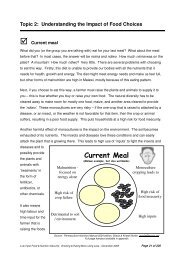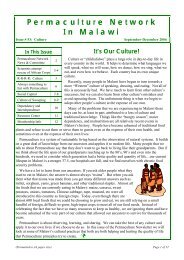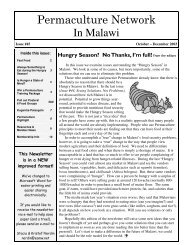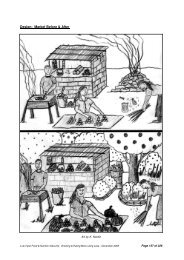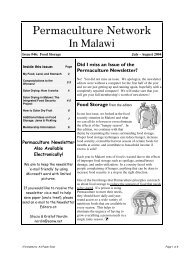Permaculture, Final Capstone Paper 5-26, Hope - Never Ending Food
Permaculture, Final Capstone Paper 5-26, Hope - Never Ending Food
Permaculture, Final Capstone Paper 5-26, Hope - Never Ending Food
You also want an ePaper? Increase the reach of your titles
YUMPU automatically turns print PDFs into web optimized ePapers that Google loves.
each focus group consisted of 6 to 9 participants falling within the suggested focus group range<br />
of 4-12 participants widely accepted in qualitative analysis (Rossman and Rallis, 2003). Because<br />
time constraints prevented a formal focus group in Nkhata Bay, interviews with Nkhata Bay<br />
participants were more in-depth and included many of the questions addressed in focus groups in<br />
other regions.<br />
Such qualitative data was analyzed primarily by coding participant responses into<br />
previously generated categories based on agriculture practices and on constraints and barriers of<br />
<strong>Permaculture</strong> Practice. This qualitative data collection provided insights that would not have<br />
been possible from quantitative data alone. Results are presented in the following sections.<br />
Qualitative data collection is at the heart of the PDI providing not only contextual information<br />
for understanding the quantitative data, but also by allowing the farmers themselves to be the<br />
experts.<br />
Limitations<br />
The design of this research emerged from the field and was heavily influenced by needs<br />
and wants of the PNM. Because access to contemporary literature on adoption of agricultural<br />
practices was extremely limited, the data collection was more general than might have been the<br />
case, resulting in a fair amount of unused information. Although the survey instrument was<br />
lengthy, there were, in retrospect, some important gaps in that data collection, such as distance to<br />
markets and civic engagement. Both areas have been addressed in the adoption literature and<br />
may have been useful explanatory factors in this inquiry. Although enough data was collected to<br />
create the variables employed and agriculturalsales, these categories emerged post-data<br />
collection and consequently, there is no qualitative information attached to these variables.<br />
25



